Abstract
1. Isolated, lumen-perfused, whole stomach preparations from mouse and immature rat produced a stable basal acid output which, although not blocked by histamine H2-, acetylcholine M- or CCKB/gastrin receptor antagonists, was almostly completely blocked by the H+/K(+)-ATPase inhibitor, omeprazole, and the metabolic inhibitor, sodium thiocyanate (NaSCN). 2. Fully-defined concentration-effect curves could be obtained on both assays with the phosphodiesterase inhibitor, isobutyl methylxanthine (IBMX) and with dibutyryl cyclic AMP. 3. On the rat stomach assay, histamine H2-receptor blockade had no effect on the IBMX curve. In contrast, the IBMX response in the mouse was abolished by histamine H2-receptor blockade. On both assays responses to dibutyryl cyclic AMP were resistant to H2-receptor blockade. 4. In the absence of suprathreshold endogenous histamine, it is argued that H+/K(+)-ATPase mediated basal acid secretion from the mouse stomach assay is regulated by something other than cyclic AMP.
Full text
PDF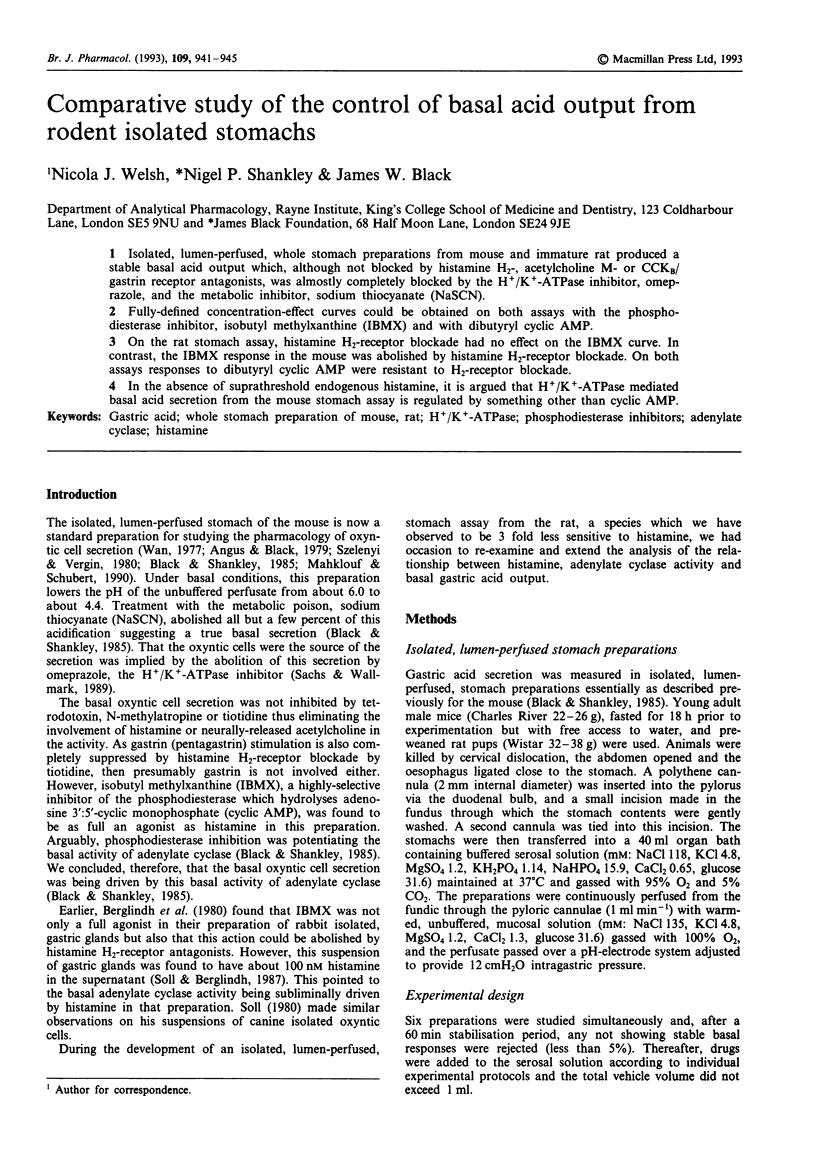
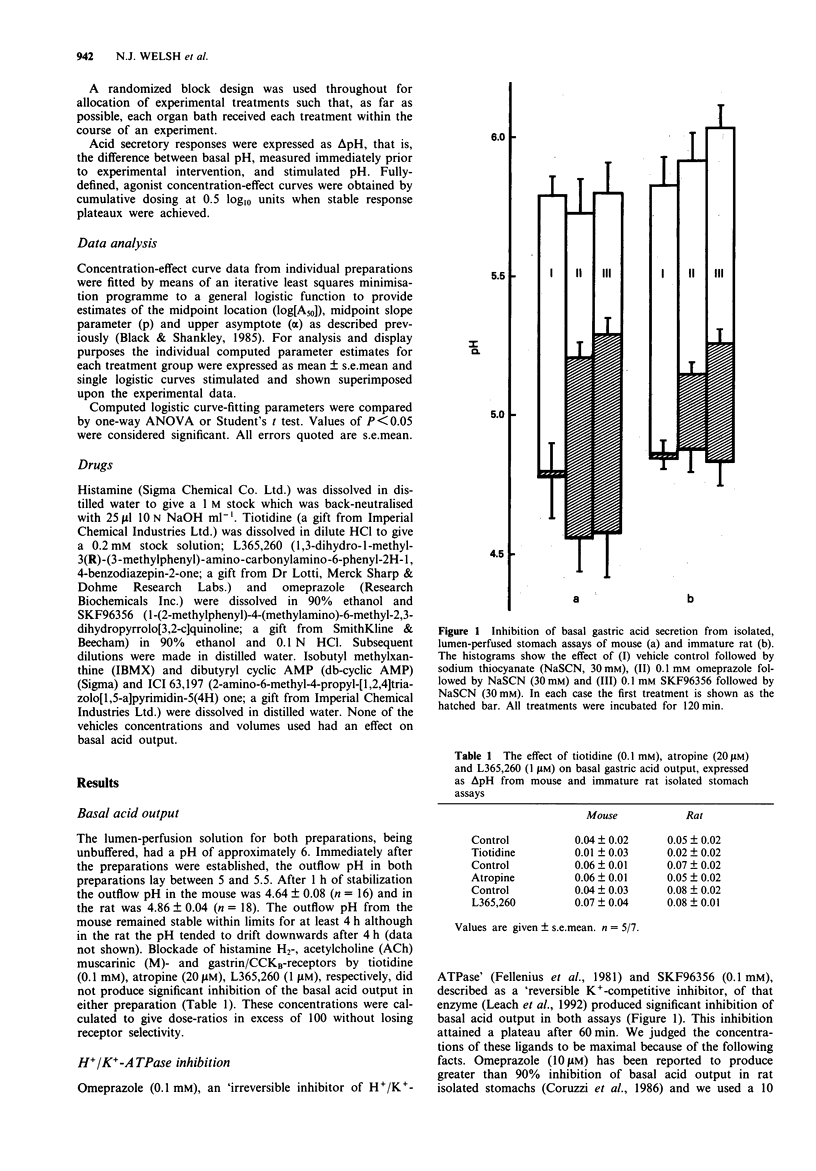
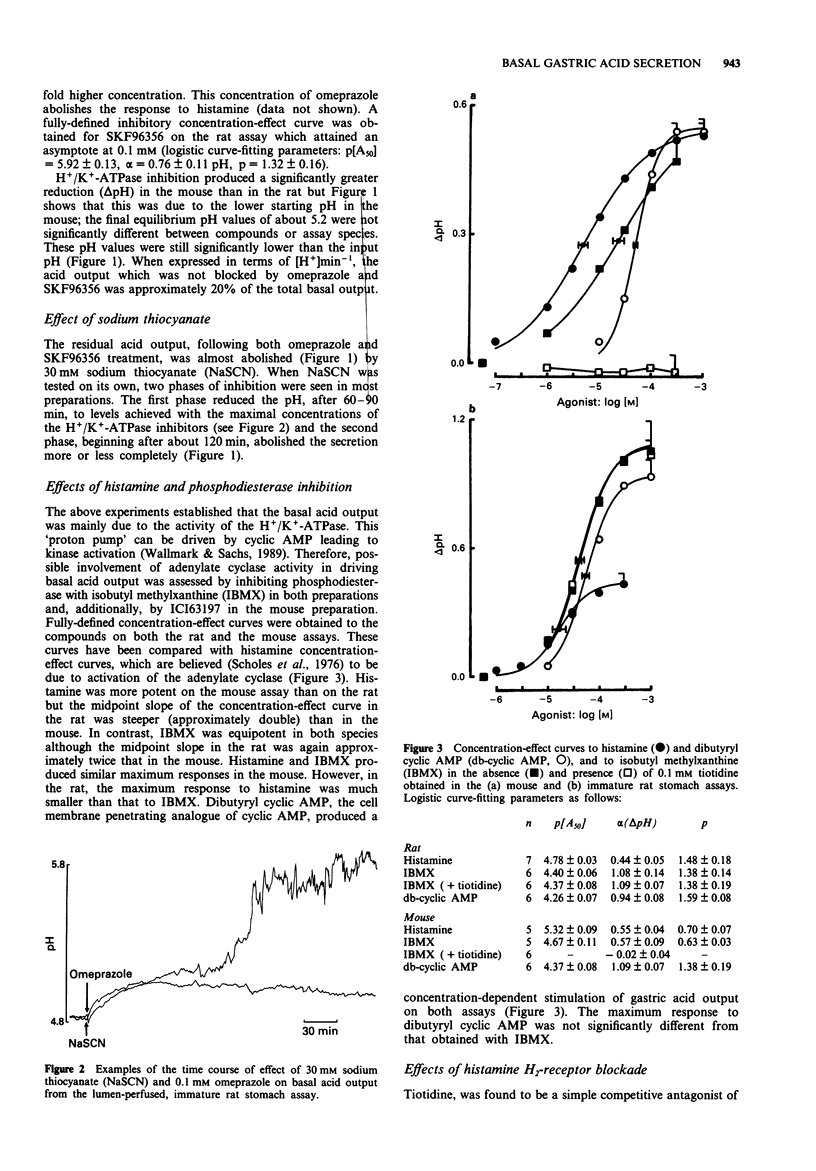
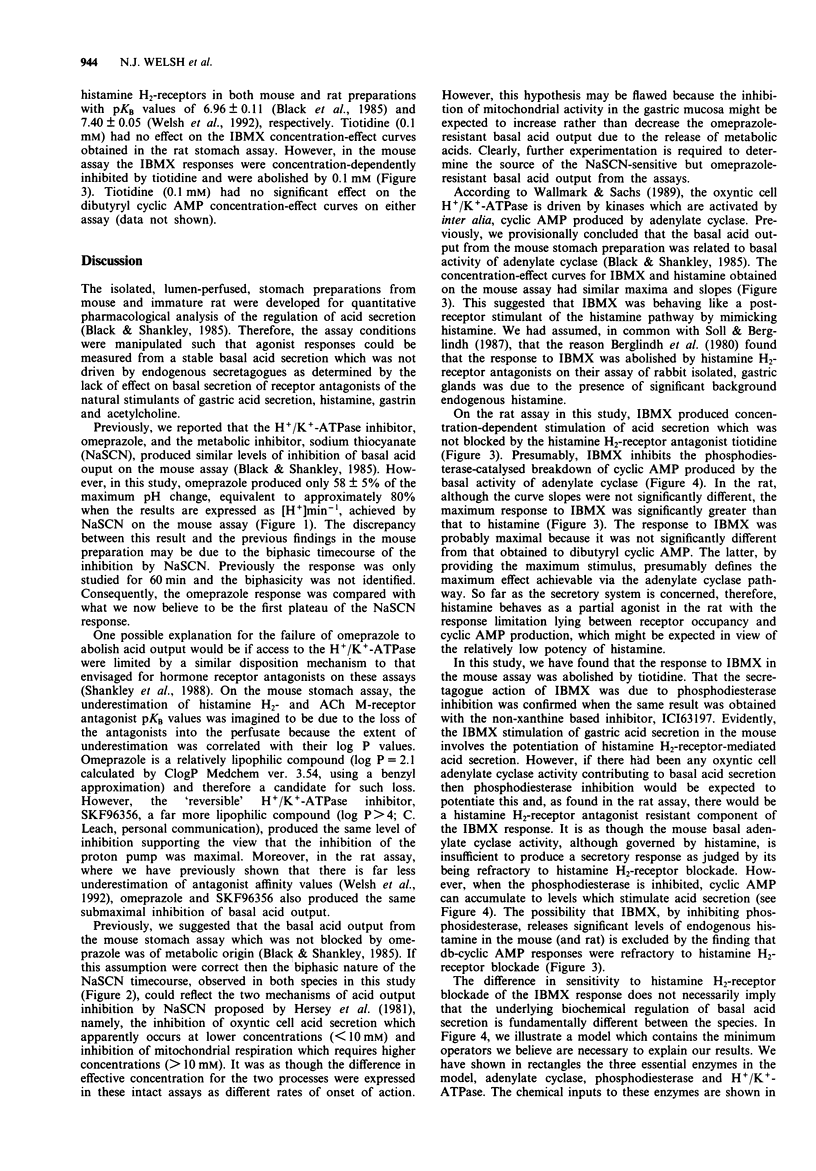
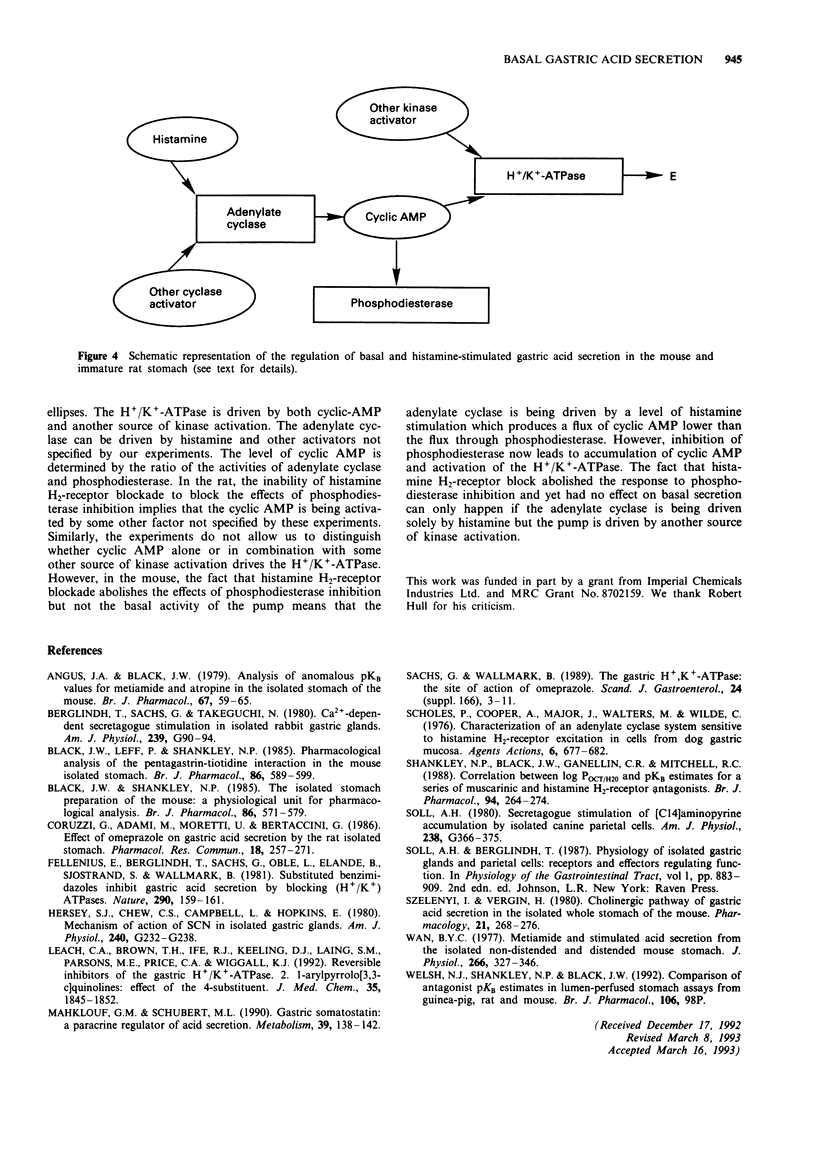
Selected References
These references are in PubMed. This may not be the complete list of references from this article.
- Angus J. A., Black J. W. Analysis of anomalous pKb values for metiamide and atropine in the isolated stomach of the mouse. Br J Pharmacol. 1979 Sep;67(1):59–65. [PMC free article] [PubMed] [Google Scholar]
- Black J. W., Leff P., Shankley N. P. Pharmacological analysis of the pentagastrin-tiotidine interaction in the mouse isolated stomach. Br J Pharmacol. 1985 Nov;86(3):589–599. doi: 10.1111/j.1476-5381.1985.tb08935.x. [DOI] [PMC free article] [PubMed] [Google Scholar]
- Black J. W., Shankley N. P. The isolated stomach preparation of the mouse: a physiological unit for pharmacological analysis. Br J Pharmacol. 1985 Nov;86(3):571–579. doi: 10.1111/j.1476-5381.1985.tb08933.x. [DOI] [PMC free article] [PubMed] [Google Scholar]
- Coruzzi G., Adami M., Moretti U., Bertaccini G. Effect of omeprazole on gastric acid secretion by the rat isolated stomach. Pharmacol Res Commun. 1986 Mar;18(3):257–271. doi: 10.1016/0031-6989(86)90123-2. [DOI] [PubMed] [Google Scholar]
- Fellenius E., Berglindh T., Sachs G., Olbe L., Elander B., Sjöstrand S. E., Wallmark B. Substituted benzimidazoles inhibit gastric acid secretion by blocking (H+ + K+)ATPase. Nature. 1981 Mar 12;290(5802):159–161. doi: 10.1038/290159a0. [DOI] [PubMed] [Google Scholar]
- Hersey S. J., Chew C. S., Campbell L., Hopkins E. Mechanism of action of SCN in isolated gastric glands. Am J Physiol. 1981 Mar;240(3):G232–G238. doi: 10.1152/ajpgi.1981.240.3.G232. [DOI] [PubMed] [Google Scholar]
- Leach C. A., Brown T. H., Ife R. J., Keeling D. J., Laing S. M., Parsons M. E., Price C. A., Wiggall K. J. Reversible inhibitors of the gastric (H+/K+)-ATPase. 2. 1-Arylpyrrolo[3,2-c]quinolines: effect of the 4-substituent. J Med Chem. 1992 May 15;35(10):1845–1852. doi: 10.1021/jm00088a021. [DOI] [PubMed] [Google Scholar]
- Makhlouf G. M., Schubert M. L. Gastric somatostatin: a paracrine regulator of acid secretion. Metabolism. 1990 Sep;39(9 Suppl 2):138–142. doi: 10.1016/0026-0495(90)90232-2. [DOI] [PubMed] [Google Scholar]
- Sachs G., Wallmark B. The gastric H+,K+-ATPase: the site of action of omeprazole. Scand J Gastroenterol Suppl. 1989;166:3–11. [PubMed] [Google Scholar]
- Scholes P., Cooper A., Jones D., Major J., Walters M., Wilde C. Characterization of an adenylate cyclase system sensitive to histamine H2-receptor excitation in cells from dog gastric mucosa. Agents Actions. 1976 Nov;6(6):677–682. doi: 10.1007/BF02026087. [DOI] [PubMed] [Google Scholar]
- Shankley N. P., Black J. W., Ganellin C. R., Mitchell R. C. Correlation between log POCT/H2O and pKB estimates for a series of muscarinic and histamine H2-receptor antagonists. Br J Pharmacol. 1988 May;94(1):264–274. doi: 10.1111/j.1476-5381.1988.tb11523.x. [DOI] [PMC free article] [PubMed] [Google Scholar]
- Soll A. H. Secretagogue stimulation of [14C]aminopyrine accumulation by isolated canine parietal cells. Am J Physiol. 1980 Apr;238(4):G366–G375. doi: 10.1152/ajpgi.1980.238.4.G366. [DOI] [PubMed] [Google Scholar]
- Szelenyi I., Vergin H. Cholinergic pathway of gastric acid secretion in the isolated whole stomach of the mouse. Pharmacology. 1980;21(4):268–276. doi: 10.1159/000137441. [DOI] [PubMed] [Google Scholar]
- Wan B. Y. Metiamide and stimulated acid secretion from the isolated non-distended and distended mouse stomach. J Physiol. 1977 Apr;266(2):327–346. doi: 10.1113/jphysiol.1977.sp011770. [DOI] [PMC free article] [PubMed] [Google Scholar]


